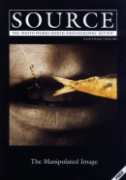Digital Deja-Vu
by Beryl Graham
Issue 3 Winter 1994
View Contents ▸
There's something about seeing students in flared trousers and platform shoes which has recently been making me feel as though I'm falling into a particularly badly designed time-warp. Visiting the new university courses in digital imaging and multimedia seems very much like visiting photography courses of twenty years ago; predominantly male lecturers paying homage to technology gods which used to be long lenses and large format, and are now big hard-drives and more RAM.
Still, even if women have to go through the battle all over again (elbowing their way through the scrum to get their hands on the technology that is) at least we've had the practice. Those platform shoes might actually come in handy for gouging a few shins. The battle might well be worth it, for despite the inevitable teething problems of a new medium, digital imaging is capable of a subtle and rich vocabulary which is only just beginning to be articulated.
Some of the things which image manipulation software such as Photoshop is particularly good at, in fact, fit in very smoothly with some existing genres of women's photography. The ease with which source images from art or advertising can be scanned, and retextualised, makes computer image manipulation ideal for subverting others, representations. Nikki West's recent work, for example, takes religious works of art and adds layers of contemporary photographs, in order to comment on religious attitudes to sexuality. She replaces Michaelangelo's Adam for instance with a naked woman, fitting in stylistically and seamlessly, in a way which would probably be impossible in the traditional colour darkroom.
What electronic imagery is supremely good at is picturing pure fantasy. Flicking through the mainstream digital imaging magazines however tends to reveal a set of fantasies about as exciting and unpredictable as John Major's dress sense. On the assumption that visual fantasies can be rather more interesting than this, there is plenty of space for women to experiment : Denise Felkin's work for example takes some family snaps as a starting point, but goes on to construct a fantasy presence of an absent father, and some highly unearthly images of babies. Being able to picture the impossible is a feature which should be bounded only by the breadth of our imaginations, not by the banality of reworking cliched surrealist icons, as found in glossy magazines.
Digital images do not of course have to be confined to the small rectangle of the computer screen. Using high quality inkjet printers, artists such as Pedro Meyer have produced large images on watercolour paper which are every bit as aesthetically tasty as those precious platinum photographic prints. The American artist Barbara Jo Revelle has upped both the scale and the durability of photographic images by digitising historical material, converting this into a pattern of small ceramic tiles in shades of grey, and covering the walls of the Denver convention centre with a mural over 100 feet long.
When digital images move into interactive multi media (The much hyped "multi media revolution" which has seen interactive CD ROMs of games, encyclopedias or pornography hit the market) the possibilities get even broader. The development of interactive computer based images has in fact come from the uncompromising background of defence technology, and continues to be inextricably interlinked with boys and toys (whether of the war or pornography variety). Never the less, the technology also offers the opportunity for rich sound, visuals, and escape from linear narratives. Because of this, it also offers the opportunities for many voices to give different views of the same subject within one body of work. In the personal work of Pat Roberts and Jocelyn Cohen for example, they have transformed their experience of being stranded by a blizzard in the Sierra Mountains into a rich, multifaceted collection of impressions, expressed in voice, image and sections of American sign language.
New technology is obviously not an art medium which comes free of attached values. Too many, computers mean male values, exploitation of women workers, multi national domination, big brother surveillance and bad computer art ! Just like photographic technology however, if "others" don't get their hands on the means of production, then we will never find out what the medium can really do. The lessons of the past, however, don't seem to have been completely ignored. The success of the London digital arts organisation Artec for example, is perhaps due to some of the staff's background in good old "community arts". The former dockland community billboard project, is now reborn as Art for Change, and is busy using digital and interactive images for some of the good old activist aims.
Some forms of interactive technology can provide the artist with a means of facilitating the audience's real participation and collaboration, whilst some just provide a new way of viewing work. In either case, the artists relationship with the audience is open to some interesting new possibilities, and these possibilities undeniably need to be explored by many more artists. Whilst electronic imaging may not necessarily be offering Utopia, it's worth picking one's way through the dreadful video games and user unfriendly software to find the new aesthetic and structural possibilities. As long as the Internet consists of millions of white male computer nerds, it will remain a deeply tedious phenomenon, but get enough "others" on the network, and we'll really see what's cookin!
Beryl Graham, a freelance curator and writer based in San Francisco and Newcastle upon Tyne. Courtesy of SIGNALS the festival of women photographers.
Other articles on photography from the 'Manipulated' category ▸






